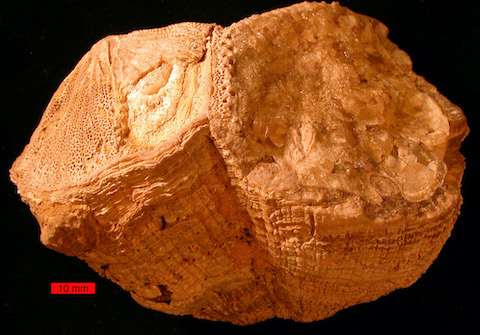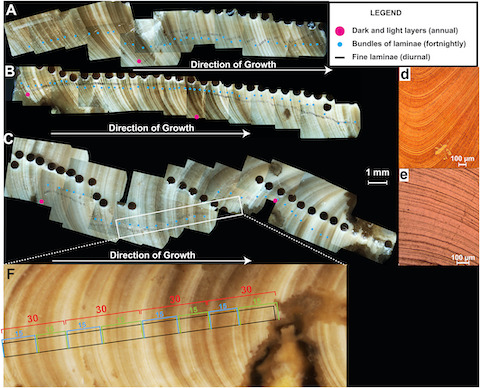
Credit: William Anders
Do you wish you could have an extra hour in the day? Well, if you can wait a very long time, you’ll get it.
That’s because the length of the day is increasing, and has been for the last billion-plus years.
Scientists recently studied a large Cretaceous mollusk with unprecedented precision. Mollusk shells grow like tree rings, adding a little bit each day.
The researchers used lasers to drill tiny holes in the shell, each the size of a red blood cell—like microscopic core samples.
From these they could examine the shell’s growth not just by the day, but by the hour.
They found that 80 million years ago, when this animal was alive, each day was half an hour shorter than today.
Going back further, to 600-million-year-old tidal sediments in Australia, they determined the day was then 22 hours long.
And 1.4-billion-year-old rocks in China suggested a 19-hour day.
All this indicates that Earth was once spinning faster than today. What’s going on?
Well, you can blame it on the moon.
The moon’s gravity causes Earth’s tides, which pull on and bulge out the surface of the oceans. Like when a spinning skater decelerates by extending her arms, the expanding and contracting seas are slowly decelerating Earth’s rotation.
But don’t worry, it’s happening very slowly—just 1.8 milliseconds per century.
Meaning it will be 200 million years before you get that extra hour.
Background
Synopsis: Leap years like 2020 remind us that every 4 years we need to add a day to our calendar year of 365 days. But Earth’s years have not always been 365.25 days long. Researchers have shown that the dance between Earth and her moon has slowed Earth’s rotation very gradually over time, lengthening our days. This means that in the past there were more Earth days per year. In fact, recent data shows that dinosaurs lived in a world with years that were a week longer, resulting in days that were about a half hour shorter.
- The number of days in our year is determined by the number of Earth rotations that occur during one solar orbit of the Earth
- Today, each Earth orbit of the sun is nearly circular, with a circumference of 584 million mi (940 million km).
- Earth travels on this annual journey at a speed of about 66,616 mi/hr (30 km/s).
- At present, the Earth rotates 365.25 times per sidereal year—when the sun and Earth return to the same spot with respect to fixed stars.\
- The extra quarter rotation each year requires that we add a day to our calendar every fourth year—the leap year—to keep in sync with the sun.

Credit: AGU Paleoceanography and Paleoclimatology
- Recent studies of rocks and fossils ranging from 620 to 72 million years old show that in the geological past there were more days in each year, suggesting Earth’s rotation is progressively slowing.
- Geological evidence from sediments and fossils are like tree rings, showing recognizable seasonal and daily variations.
- Recently, researchers did an extremely precise study of a well-preserved shell that is 84 to 72 million years old.
- The shell belonged to a Torreites sanchezi rudist—a vase-shaped bivalve with a clam-like lid at its wide end.
- Rudists grew as colonies in reef-like structures similar to today’s oyster beds and became extinct at the end of the Mesozoic, along with the dinosaurs.
- Annual variations in trace elements and stable isotopes showed that this rudist lived for 9 years.
- Scientists examined the shells with unprecedented precision, using lasers focused to sample holes only 10 micrometers in diameter—about the size of a red blood cell. They were able to take 4–5 samples for each Cretaceous day.

Credit: AGU Paleoceanography and Paleoclimatology
- While it was alive, the rudist grew every day, depositing multiple distinct layers per day that showed two amazing things:
- The bivalve grew more during the day than at night, indicating it was getting help from a daylight-loving symbiotic photosynthesizer, like algae. These relationships occur in today’s corals and giant clams, but this is the first evidence of symbionts in organisms as old as these rudists.
- The number of days recorded for the 9 years of shell growth was 372 per year—7 days longer than our modern year. Earth had to rotate faster during its annual orbit to produce this extra week each year for the rudist.
- Researchers believe that during the Cretaceous it took the Earth the same amount of time to orbit the sun as today (8760 hours), so with a year of the same length and 7 extra days, this would mean each day was 30 minutes shorter for the dinosaurs, or just 23.5 hours long.
- Other studies show that Earth’s rotation has been slowing, decreasing the number of days per year over geological history.
- Changes in solar radiation recorded in China’s 1.4 billion-year-old Xiamaling Formation suggest that back then, Earth’s days were just 18.7 hours long, and there were nearly 500 days (rotations) per year.
- Tidal rhythmites in Australia record layer upon layer of very fine grained sand from 620-million-year-old Cambrian deposits that reveal 400-day years and 21.9-hour days.
- Carboniferous corals from 350 million years ago record 385-day years and 23-hour days.
- Even cultural records of solar eclipses show the lengths of days have changed, since models show that eclipse shadows would not have fallen in the places where scribes actually recorded them unless our days have lengthened a tiny bit since 1200 BC.
- The moon causes Earth’s tides, which bulge and decelerate Earth—just like a figure skater decelerates from a tight spin by opening up their stance after the spin.
- The tidal bulges rotate slightly ahead of the moon because Earth rotates faster than the moons orbit. The bulge tugs the moon forward, accelerating it and transferring energy from Earth’s spin to the moon’s orbit.
- This tidal friction also causes the moon to slowly drift away from Earth at about 1.5 inches (3.82 cm) per year. We know this because we can use lasers to measure the distance to reflectors deployed on the moon during the Apollo missions.
- Tidal friction is thought to be greater today than in the past because of the arrangement of Earth’s landmasses, which contributes to the size of the tidal bulge.
- Earth’s rotation is slowing because of its relationship with our moon.
- Earth’s days are getting longer by about 1.8 milliseconds per century.
- That means it will take 3.3 million years to add one minute.
- It will take 200 million years to add that extra hour to our day that we all are wishing for. But there would only be 350 days in the year at that point.

